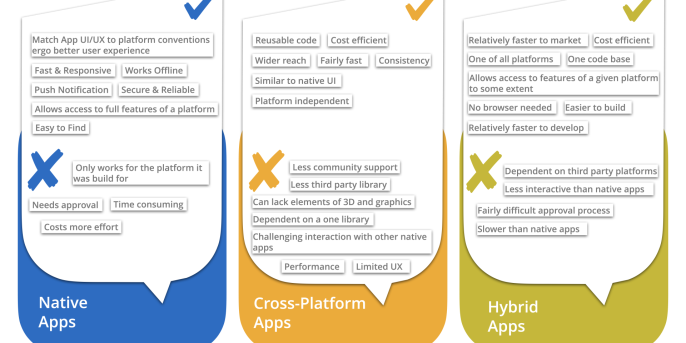19. June 2020 By Başak Akbulak
Mobile Application Development: Choosing The Right Approach For Your Business
The first multi-touchscreen smartphone was introduced in 2007, and the usage of smart mobile devices has been growing rapidly ever since. According to a research by Statistica, as of now, there are 3.5 billion smartphone users in the world https://www.bankmycell.com/blog/how-many-phones-are-in-the-world, which make up 45.12% of the world population. But there’s another industry that has been growing alongside with mobile devices: Mobile applications.
Mobile applications have come a long way since that Snake game we played on our Nokia phones back in 1997. Today, the mobile application ecosystem is one of the biggest industries with millions of users all around the world. And considering mobile users are spending 87% of their time in apps, according to a research by ComScore https://mindsea.com/app-stats/, we can safely say they have a significant place in our daily lives.
There are, of course, many angles to approaching a subject like mobile apps. But we are looking at it through the perspective of our core business: Software development. So we are going to talk about different types of mobile apps, and how to choose the right one for your business.
Types of mobile applications
As you may have already known, there are different types of mobile applications such as: Native Apps, Cross-platform Apps, and Hybrid Apps.

Native Apps are apps that are designed for a specific mobile platform. This means that they are coded in a specific programming language, such as Swift for iOS or Kotlin for Android. That is to say, native apps cannot be used on different platforms. Developers prefer to build native apps to get the most out of the platform they are building for; performance, consistency and user experience wise.
A good alternative to building platform-specific native apps is developing Cross-Platform Apps. Some third-party platforms enable us to build cross-platform apps. For example, Facebook’s React Native, Google’s Flutter and Microsoft’s Xamarin. Effectively what these third-party platforms do is turn a single codebase into native language that can run in different platforms or operating systems. Developers prefer to build cross-platform apps to reduce cost and save time while keeping the platform independent position.
Hybrid apps are apps written with the same technology applied for websites and is deployed in a native container. Developers prefer to build hybrid apps to test the product. With this in mind, they are actually a simple version of a product that acts like an MVP. So it is an easier way to find out whether the users will download the app or not.
How to choose the right application for your business
It is important to decide which type of app fulfills the needs of the design and the users. So how do we decide?
We treat technical and user experience aspects of the analysis process as a whole, not as two separate entities. During this process, with the joint work carried out by our UI/UX and software teams, we get to know the user audience of the application, fully understand the expected features and determine the technical requirements in detail. From there, with the concrete data at hand, it becomes easy for our customers to choose the right technology.
Understanding the different offerings each app type has and comparing the attributes to your needs is the key. Every app type has both pros and cons; different DNA’s. To turn this into an advantage you should understand what you are building and who are you building it for. Essentially it all comes to these two: needs and users.
PRO-Tip: If you want to build an app to reach end-users with high response rates and great user experience then you should start thinking about building a native app. It might cost more but the result might be just what you need. Native apps are known to work smoothly with the platform that they are built for with fast smooth transitions and full feature access.
PRO-Tip: If what you are looking for is an app that will be used internally that does not need an emphasis on user experience, will require a fair amount of updates and does basic tasks then a hybrid app might be a great choice. They are fast to develop and fairly easier and faster to build with one codebase.
PRO-Tip: If what fulfills your needs is a little bit of both and you feel adventures enough, you can dip your toes into the still developing and upcoming cross-platform apps.

